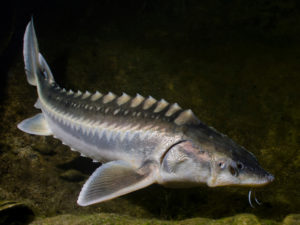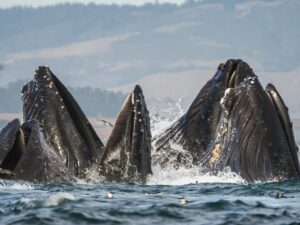When fishing, I like to set low expectations for the day.
Such was my mindset recently when I joined up with my friend Don and a group of neighbors from Half Moon Bay aboard the New Captain Pete for a day of salmon fishing. As far as California’s salmon fishery goes, the Sacramento River’s fall chinook run essentially collapsed in 2008, and salmon fishing went down with it for the next three years.
But with gradual improvements in population numbers and the official forecast for a large return to the Sacramento River in 2012, all signs pointed to a huge rebound and I remained cautiously optimistic.
At 5:15 in the morning, Elizabeth Knier’s mood was cheerful by anyone’s standards. The “salmon bite” was in full swing and the line of anglers extending out her shop at Pillar Point Harbor was obvious proof. Elizabeth owns Bait & Switch Sport fishing, which manages a small fleet of sport-fishing boats. On this Sunday morning, she had her hands full getting customers ready with fishing licenses, tackle kits and cups of coffee for their boats leaving within the hour. I paid my charter trip fee and headed down the dock to board the 53-foot boat as predawn light glowed through the fog.
Chinook or king salmon would be our quarry as we trolled north to the Golden Gate. The other salmon species typically encountered off-shore of California is coho or silver salmon. Keeping coho salmon, however, is prohibited in all California ocean fisheries as well as any inland stream. The regulation serves to protect an extremely fragile population of coho, which return to their natal streams ranging from Santa Cruz to Southern Oregon.
Unlike the fall chinook run on the Sacramento River which can number over 500,000 adults, the sum of all coho returning to spawn in California each year is estimated at somewhere between 500 and 3,000 adults. Since the 1980’s, California’s coho has been in steep decline and have been listed under both the state and federal endangered species acts. Recent efforts to protect coho include a federal recovery plan to restore the fish to Central Coast streams and a new state law streamlining habitat restoration projects.
The morning troll for chinook was successful and by early afternoon the New Captain Pete turned back for Pillar Point. A small flock of western gulls glided behind the boat as we docked and the deckhand distributed some 30 chinook salmon amongst a group of satisfied fishermen. My mindset of low expectations seemed to work per plan. As we left the dock, I heard a woman ask a man in front of me, “So, how was the fishing?” He held up his large bag with two salmon, and said, “It was a good day. Salmon fishing was good.”
After four years of closures and shortened seasons, recent news reports have declared that the California king salmon is back! Reading those reports, I wonder if the situation for California’s chinook is that simple. Unfortunately, all of California’s salmon face a future where the state’s thirst for freshwater will continue to grow, fish hatcheries will produce the majority of their population, and greater swings in the ocean’s surface temperature will radically change the availability of their food. As a long-time fisherman, I’m keeping my expectations dialed down, but quietly waiting for the upside surprise.
Important note: if you’re planning to fish for salmon in California waters, be certain to properly identify any caught fish before keeping them. Coho salmon should be identified through examination of mouth and gums. The base of the bottom teeth on a Chinook salmon is all black whereas coho salmon have a narrow light gray band. A photo guide is viewable here.
Michael Carl is author of “Long May They Run: The Quest for Coho from Santa Cruz to Marin” in the October 2012 issue of Bay Nature Magazine.





